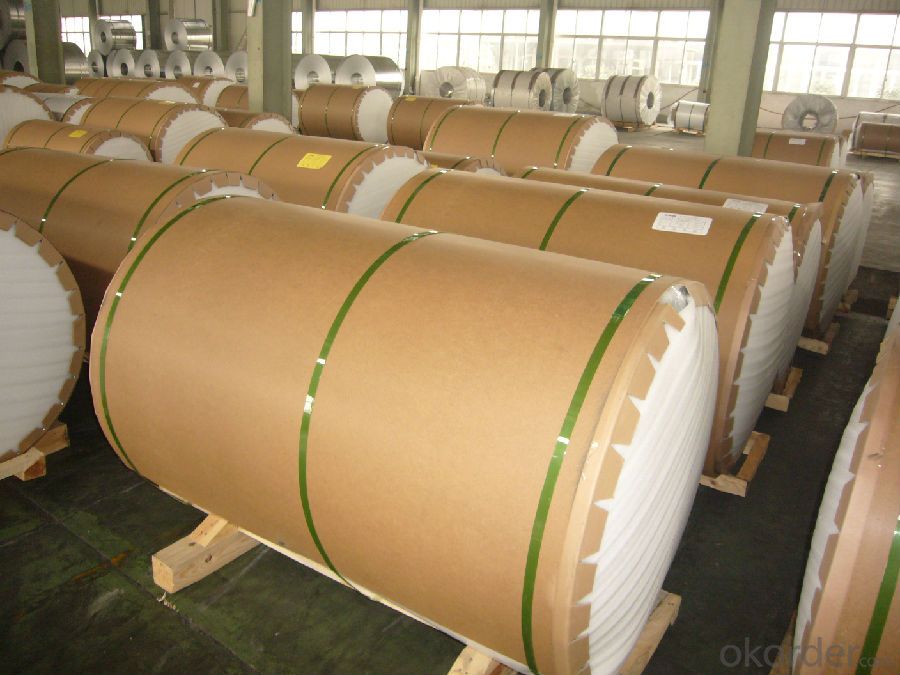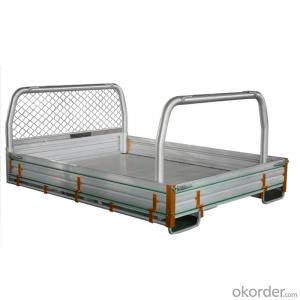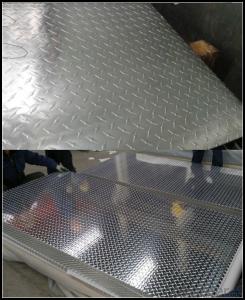Embossed Aluminum Coils for Bus Building - Aluminum Sheets in Vermont
- Loading Port:
- Shanghai
- Payment Terms:
- TT OR LC
- Min Order Qty:
- 5 m.t.
- Supply Capability:
- 5000 m.t./month
OKorder Service Pledge
OKorder Financial Service
You Might Also Like
Specification
1.Structure of Embossed Aluminium Coils for Bus Building
Embossed Aluminium Coils for Bus Building is one semi-finished aluminium material. This strip can be rolled down to aluminium coil,sheet,circle ect. The alloy AA1050 is widly used in building, industry ect. Its weight is much lower than steel. So many customers choosed aluminium material instead of steel.
2. Main features of Embossed Aluminium Coils for Bus Building
a.Competitive price---We have our own mills and can produce mill finished aluminium coils, so we can control the production cost better.
b.Professional after-sale service---We have more than 15 years exportation experience and you need not worry about the exporation problems.
c.Fast delivery time---We can control the delivery time within 35 days.
3. Image



4. Product Specification
| ALLOY | TEMPER | EMBOSSED | THICKNESS | WIDTH |
| AA3003 | H18 | FIVE BAR | 2MM-3MM | 1000MM-1500MM |
5.FAQ:
What is the quality standard?
---Usually our standard is GB3880-2006
What is the largest width?
---It is 2300mm
What is the MOQ?
---Usually we can accept 80 tons.
- Q: Can aluminum sheets be used as heat shields?
- Yes, aluminum sheets can be used as heat shields. Aluminum has excellent thermal conductivity, meaning it can efficiently conduct and transfer heat away from the source. Additionally, aluminum has a high melting point, allowing it to withstand high temperatures without warping or deforming. These properties make aluminum sheets an ideal choice for heat shield applications, such as protecting sensitive components or structures from heat damage in various industries including automotive, aerospace, and industrial applications. Furthermore, aluminum is lightweight and relatively easy to shape, making it a practical choice for heat shields that need to be installed in tight spaces or require complex designs. Overall, the use of aluminum sheets as heat shields offers effective thermal protection while providing durability, versatility, and cost-effectiveness.
- Q: write a balanced equation for the reaction between aluminium metal and potassium hydroxide in water
- So convert 27,8 g iron to moles, and convert that to a mass of aluminium 2. 3 CuNO3 + Fe3+ -- Fe(NO3)3 + 3 Cu+ 3. 2 Fe3+ + 3 O2- --- Fe2O3 So convert Fe2O3 from 20,8 grams to moles. Multiply this answer by two. Convert to a mass of Fe3+ 4. H2SO4 + 2 KOH -- K2SO4 + 2 H2O again, 150 grams of H2SO4 to moles, then convert that amount to an amount of mass of K2SO4 5. Na2CO3 + 2 H3O+ + Cl- --- CO2 + 3 H2O + NaCl
- Q: Can 101 aluminum sheets be bent without cracking or breaking?
- No, it is highly unlikely that 101 aluminum sheets can be bent without cracking or breaking.
- Q: Cooks are warned not to use aluminum cookware when preparing acidic foods. Why?
- The reacton will make the food taste bad..metalic. Aluminun will poisen your body. We should never use alluminum cookware.
- Q: What are the different types of surface treatments available for painted aluminum sheets?
- There are several types of surface treatments available for painted aluminum sheets, including anodizing, powder coating, and laminating. Anodizing involves creating a protective oxide layer on the surface of the aluminum, providing enhanced durability and corrosion resistance. Powder coating involves applying a dry powder onto the aluminum surface and curing it to create a durable and decorative finish. Laminating involves applying a protective film onto the painted aluminum sheet, providing additional protection against scratches and UV radiation.
- Q: which kind of aluminum sheet could be bended after being etched?
- general etching materials include stainless steel and copper.
- Q: Are aluminum sheets easy to clean?
- Yes, aluminum sheets are generally easy to clean due to their smooth surface and non-porous nature, allowing for easy removal of dirt, grease, and stains with regular cleaning agents.
- Q: Can aluminum sheets be bent or formed?
- Yes, aluminum sheets can be bent or formed. Aluminum is a highly malleable and ductile metal, which means it can easily be shaped or bent without breaking. This characteristic makes it a popular choice for various applications, such as manufacturing automotive parts, aircraft structures, and household items. Aluminum sheets can be bent or formed using various techniques, such as press braking, roll bending, and stretch forming. These methods allow the aluminum sheets to be shaped into different angles or curves to meet specific design requirements.
- Q: What is the typical fracture toughness of aluminum sheets?
- The typical fracture toughness of aluminum sheets can vary depending on a variety of factors such as the alloy composition, heat treatment, and manufacturing process. However, on average, the fracture toughness of aluminum sheets ranges from 20 to 40 MPa√m. This value indicates the material's ability to resist crack propagation and withstand applied loads without fracturing. It is worth noting that aluminum alloys can be further enhanced with various strengthening techniques, such as alloying elements and grain refinement, which can improve their fracture toughness. Therefore, it is essential to consider specific aluminum alloys and their respective processing conditions to determine the precise fracture toughness of aluminum sheets in a given application.
- Q: Heating aluminum plate, heating scheme, urgent ~!
- For aluminum heating silicon heating plate is a good choice. The four corners can be fixed by screws, Beijiao can. Installation is very convenient. I was in the goodway procurement. They are guaranteed for one year.
Send your message to us
Embossed Aluminum Coils for Bus Building - Aluminum Sheets in Vermont
- Loading Port:
- Shanghai
- Payment Terms:
- TT OR LC
- Min Order Qty:
- 5 m.t.
- Supply Capability:
- 5000 m.t./month
OKorder Service Pledge
OKorder Financial Service
Similar products
Hot products
Hot Searches
Related keywords




























